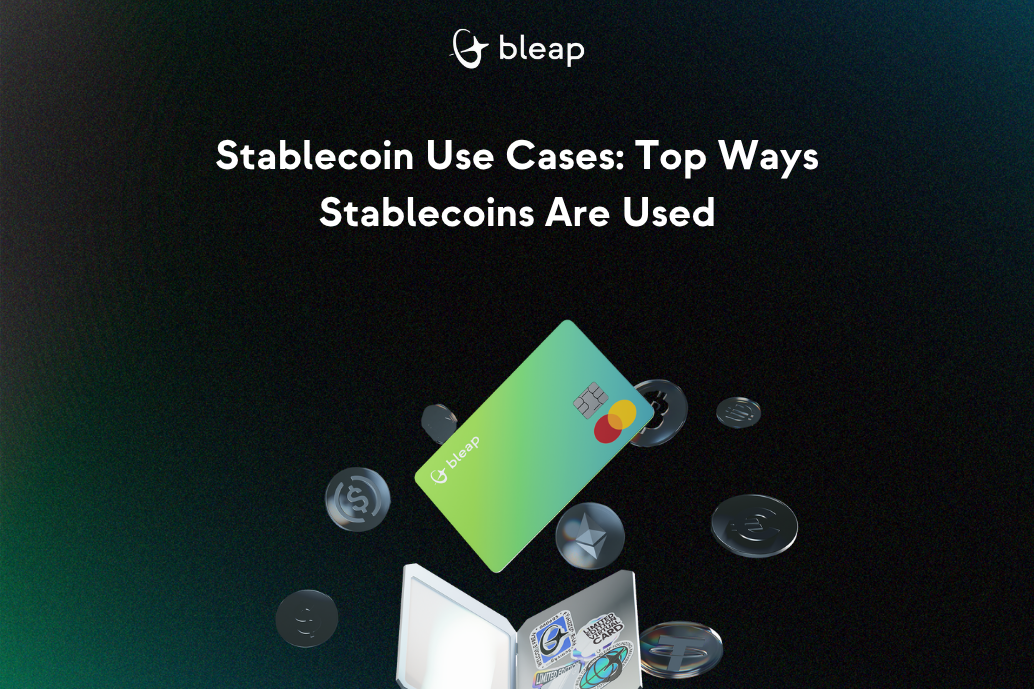
Stablecoins and DeFi investments carry risks, including volatility, smart contract bugs, and regulatory uncertainty. This content is for educational purposes only and does not constitute financial advice. Always research before using decentralized protocols.
Stablecoins are cryptocurrencies designed to keep a stable price, usually pegged to the U.S. dollar. Their most common use cases include payments, remittances, DeFi yield, trading, and treasury management, making them essential for both individuals and businesses in 2025.
Stablecoins make sending money across borders as simple as sending a text.
Traditional transfers can take days and cost up to 10% in fees. With stablecoins like USDC, USDT, or DAI, transfers settle in seconds and cost just a few cents.
Bleap leverages this principle by letting users send and receive stablecoins or fiat instantly, with no FX markups or hidden fees.
Stablecoins are the backbone of Decentralized Finance (DeFi). They power lending markets, yield protocols, and liquidity pools that offer stable returns.
According to DeFiLlama, stablecoins represent over 75% of all DeFi liquidity, proving their central role in decentralized markets.
With Bleap, users can access DeFi yields up to 10% AER on stablecoins through Angle, Sky, or Lido, directly from a non-custodial MPC wallet.
Stablecoins act as safe havens for traders during market volatility.
When crypto prices drop, they convert assets into USDC or USDT to preserve value without leaving the blockchain.
They also enable deep liquidity pools for major trading pairs like BTC/USDC and ETH/USDT, which dominate crypto exchanges globally.
Stablecoins bridge the gap between crypto and real-world finance.
They allow users to seamlessly move between fiat and crypto, or spend stablecoins directly.
This use case turns stablecoins into practical, spendable money, enabling instant, borderless payments anywhere Mastercard works.
Companies use stablecoins for cross-border settlements and treasury diversification.
They provide speed, transparency, and lower operational costs.
Startups, freelancers, and DAOs use stablecoins as operational cash, reducing reliance on traditional banks while staying globally connected.
In countries with unstable currencies, stablecoins act as a lifeline.
They offer access to USD-equivalent value, protecting purchasing power against inflation.
This accessibility represents true financial inclusion, open, borderless, and censorship-resistant.
Stablecoins are also transforming digital payments.
E-commerce platforms and Web3 apps use them for faster transactions, reduced fees, and no chargebacks.
Because they operate on-chain, all transactions are transparent, secure, and easy to audit.
Institutions now use stablecoins for settlements, treasury management, and tokenized deposits.
Even traditional networks like Visa and PayPal have integrated USDC for merchant settlements.
Stablecoins are redefining how money moves globally, combining blockchain efficiency with financial trust.
While stablecoins are powerful, users must understand the risks:
Tip: Prefer transparent and regulated stablecoins like USDC or over-collateralized options like DAI for safer long-term use.
According to CoinMetrics, stablecoin transaction volumes surpassed $10 trillion in 2024, exceeding Visa’s annual payment volume.
USDC and USDT together account for over 90% of total market capitalization, solidifying their role as the backbone of digital finance.
Stablecoins are no longer just a crypto experiment, they are the bridge between traditional money and decentralized finance.
They enable faster, cheaper, and more transparent global transactions while preserving price stability.
Apps like Bleap make this innovation accessible to everyone, turning stablecoins into usable, yield-generating money you can spend, save, or send globally.
They are used for payments, remittances, DeFi yield, trading, and business settlements.
Yes. You can lend or stake stablecoins in DeFi protocols or use apps like Bleap that connect directly to yield platforms.
Transparent, fiat-backed stablecoins like USDC are generally considered safer, but users should verify reserve audits and regulation.
They make blockchain practical for everyday finance by offering stability and low transaction costs.
Yes. With cards like Bleap Mastercard, you can spend stablecoins anywhere Mastercard is accepted, online or offline.
Features
Improvements
Bug fixes